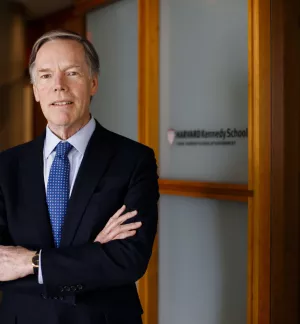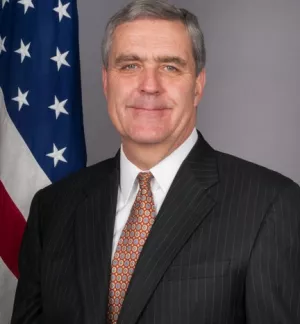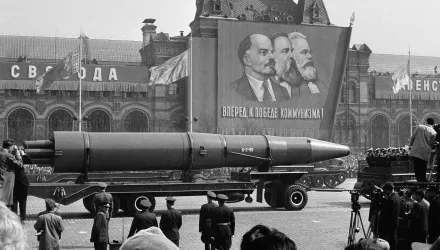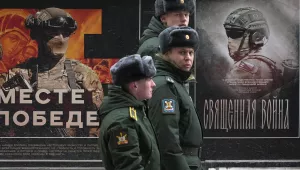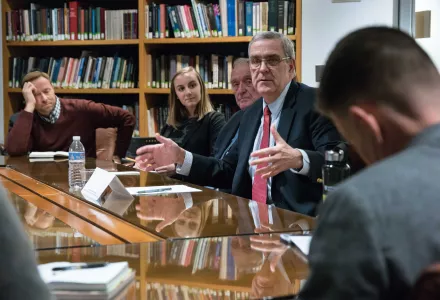
"We’re neighbors. Russia is NATO’s most capable, armed, neighbor, indefinitely. The question is, what kind of neighborhood do we want to live in?” said Ambassador Douglas Lute, Senior Fellow with the Future of Diplomacy Project in his discussion with Faculty Director, Nicholas Burns November 8, 2017 at the Belfer Center for Science and International Affairs.
"We are in the second strategic inflection point in the history of the NATO alliance,” he noted; the first being the cataclysmic changes that accompanied the dissolution of the Soviet Union. Twenty-six years after the end of the Cold War, NATO now faces a set of critical challenges from its Eastern neighbor. In Ukraine, Russian incursions into Crimea and ongoing conflict in the Donbass Region — both violations of international law — and increasing Russian threats and incursions into NATO waters and airspace, Lute listed as “NATO's list of Russia's original sins." Add to that list, Russia's hybrid warfare with interference in U.S. elections as a tactic, threatening near collisions between with NATO planes in international air space, and an evolved nuclear doctrine that proposes using nuclear weapons to "deescalate" conventional conflict. Russia has signaled its intent.
“What is Russia to us today? Strategic partner, friend, adversary?”
“NATO has not labeled the relationship,” Lute replied to the question from Faculty Director Nicholas Burns and U.S. Ambassador to the North Atlantic Council as well from 2011-2005. Instead, NATO focused on redefining a strategy that meets current threats with a two-pronged approach of strength and dialogue. “Even though dialogue is not the most comfortable thing right now or obvious it remains key in NATO’s strategy." Since 1997 the NATO-Russia Founding Act on Mutual Relations set a precedent for a NATO and Russia mechanism in which they could consult and cooperate. Though halted in 2008 and again from 2014-2016 over the Russian incursion into Ukraine, the NATO-Russia Council has been meeting on a quarterly basis again since.
While constructive dialogue remained the first objective in relations with Russia, the Alliance continued to adapt to new challenges. Lute described an “almost Kennedy School-like exercise; going back to Schelling and the basics of deterrence” in which NATO modernized its deterrence approach, including adding more conventional force structures, such as forward ground presences in Latvia, Estonia, Poland and Lithuania. In light of Russian challenges, the U.S. reiterated its commitment to NATO allies and to respond to Russian aggression unilaterally by deploying U.S. Armored Brigade Combat Teams in Europe.
NATO's members states are also central to the redefined strategy. For example, the strategy includes resilience as a tenet of deterrence. Each member state has to develop resiliency to external threats but also domestic threats (i.e., Russian mobilization of Russian ethnic populations in Estonia). "Resilience deserves the most attention and is where we are most vulnerable."
Lute assured, NATO is not stagnating in its 68th year. “It will prove adaptive.”
Lute, Douglas. “NATO and Russia: An Uneasy Relationship.” November 8, 2017



